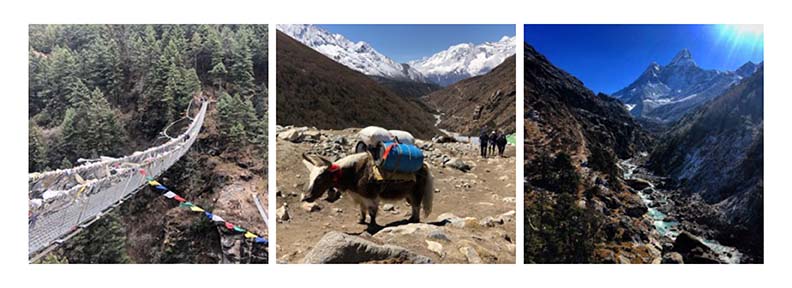We fly from Kathmandu to the small mountain village of Lukla. The airstrip we are aiming for is canted upward at a disturbing angle and ends abruptly in a cliff wall that rises several thousand feet above the village. It’s a one shot deal and the pilot and aircraft must perform perfectly. We have officially arrived in the Khumbu valley. Direct line from here is only slightly more than 40 miles to Everest Base Camp but that doesn’t really tell the story. The path we will follow is carved stone and dirt that, other than helicopter, is the only access to vast regions of the country. The side walls of the valley are nearly vertical and the path weaves a course through them that undulates in wild ups and downs and seems to spend little of its length or effort making actual progress toward our first objective of Everest Base Camp. The most remarkable features of the path are the carved Mani Stones, prayer flags and monuments that line its boarders and mark the path forward. These carved and painted prayers are appeals to the gods for health, success and for protection against the unknown; a constant reminder of our subject of risk. While I try to fully embrace the spiritual aspects of the journey we will rely, as much as possible, on actual systems and leave as little to the gods and luck as we possibly can.
As we are approaching the mountain it seems like a good moment to touch on how we approach its associated risks. I don’t believe there is a perfect answer but almost all modern risk philosophies, whether they favor a quantitative or more qualitative approach, follow a pattern or system. It begins with Identifying, to the greatest extent possible, the hazards, trying to come up with mitigations, implementing the plan, and finally, evaluating what was learned. We are continually attempting to capture what went right and what went wrong in an effort to strengthen the system and improve the outcome. The salient point in any effective method is that the system is “alive” to the greatest extent possible. It requires engagement, the collection and evaluation of data and critically, the continued application of what gets learned. Over the next few weeks I’ll attempt to tear down the component parts of these systems and discuss how they interrelate, and reinforce each other, but for now here are a few simple questions you need to ask yourself, or your team, if you are about to embark on something new where potentially costly mistakes can be made. Do you have (chosen/defined) a system? How well does that system capture and use the lessons that are learned? And finally, do you have buy in, do your people understand and use the system?
Having some type of defined and methodical approach is the difference between the amateur and the professional. The teams here on the mountain that systematically identify and mitigate the hazards of the environment are largely successful. The teams that do not are easily spotted and are a constant danger to themselves and to those around them. Their results are unpredictable, and tragically, routinely fatal. The simplicity of the lesson is just this: In any of your endeavors, or aspects of your life that are trying to improve, that you don’t have a way to effectively gather, absorb, and use new information, you are left with ritual and luck and are actively abandoning your best chance at achieving the desired result.

All the best
Fred Alldredge
Pheriche, Nepal
Facebook: Fred P Alldredge
Instagram: fredall99


